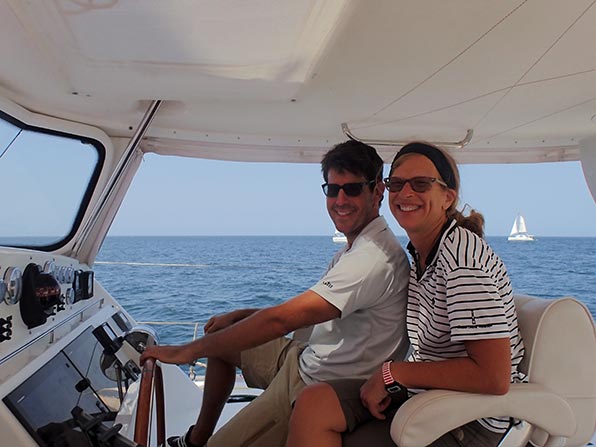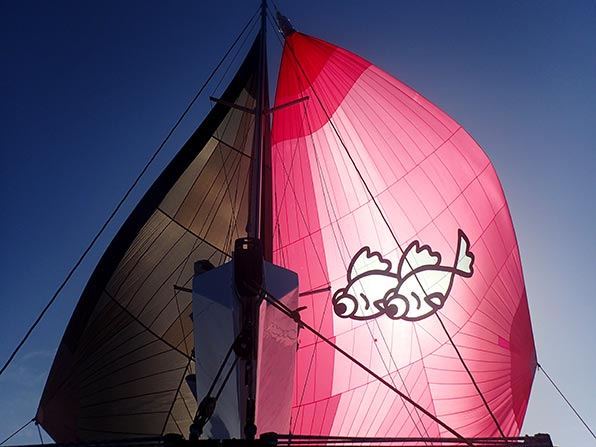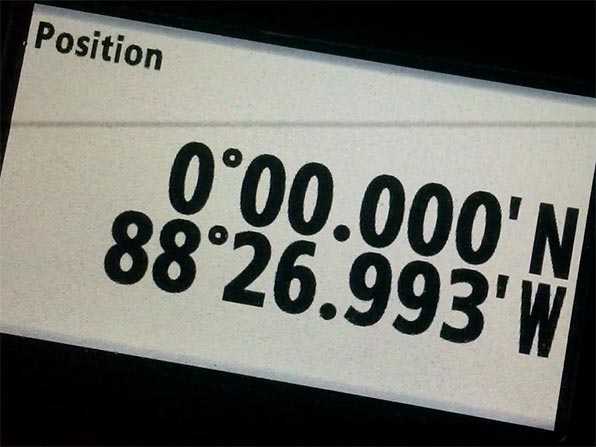Land Ho!
Hello faithful readers. Thank you for standing by as we were offshore and unable to post. We have countless stories and photos to share but to get us started, here is a quick recap of our past week’s adventures.
- February 12, 2016

The sunset entertainment in an anchorage often involves the anchoring antics of the late arrivers. Frequently, with light receding and often less available area to drop the hook, the best spots having already been snapped up by those who arrived earlier in the day, it can make the job of getting set for the night a little more challenging. It’s seldom life threatening, at least until a big storm pops up. Last night’s sunset drama was a bit more serious though.
With the rally set to depart today, everyone gathered on the beach for a farewell party and barbecue. Unfortunately, Mother Nature was welcoming everyone to shore with a breaking surf. Landing a dinghy in such conditions is never easy. When the tender is laden with party goers who don’t want to get wet, it is even more sketchy. Luckily for many, a number of rally staff and crew members were there to wade out into the surf to try to prevent the dinghies from turning broadside to the waves and getting flipped. In fact, I don’t think a single one had a serious mishap. Watching from the shore though, there certainly looked to be some tense moments.
- February 13

If you ain’t rubbing’, you ain’t racing. That quote from the Nascar inspired movie Days of Thunder could very well have been written about our beginning of the rally. As the seconds ticked down to the official 11:00 AM start, and we approached the line with main and screecher set, a boat cut in front of us leaving us no room to maneuver. Fortunately, the bump they gave us didn’t leave a mark, nor did it dampen anyone’s spirits. It did reaffirm for me that I’d rather not end up that close to a bunch of other sailboats while underway in what is our home, not a race boat!
The first day at sea was busy for the entire crew. With variable conditions, we went through every variant of sail plan that Two Fish has to offer. We traveled downwind with the main all the way up, and also with it reefed (this changed multiple times). On the bow we sailed with the genoa, the screecher, and the spinnaker, sometimes with two of them set opposing one another. We alternated between sailing on a broad reach, and wing on wing. In other words, we were pretty busy!
- February 14

As I wrote above, the first day of the rally saw us very busy trying to maximize both boat speed and comfort by frequently modifying our sail plan. So much so that we didn’t even attempt to catch a fish. At the end of the day, when all of the rally boats checked in by SSB radio, it was extremely difficult for us to listen to the reports from the other boats, bragging of the fresh fish that they’d caught for dinner. We were determined to catch our share the next day. Unfortunately, even though we had all the right gear, we ended our first day fishing without landing anything. My excuse is that we were sailing too fast!
As with all of the boats in the rally, our efforts to speed our way to the Galapagos continued. The pack had thinned out considerably though, with only a few boats remaining in AIS range. By my estimate, we’re about in the middle of the pack, sailing pretty close to the rhumb line.
- February 15

At one point, as we came on deck at 2:00 AM to begin our watch, Jason instructed us that we were going to raise the spinnaker and screecher in tandem. Although we were skeptical, after doing so, the boat rode amazingly well for the next four hours, until the breeze built beyond the safe operating range of the light-air sails, necessitating yet another sail change.
In the morning, with good light, we once again deployed our fishing lines. Unlike the previous day, this time our efforts were rewarded with a beautiful yellow fin tuna. Gail had threatened me with a vegetarian meal if we didn’t catch a fish. Perhaps that’s all we needed? 🙂
For the second time of the passage, we were paid a visit by a pod of dolphins. Other boats in the fleet reported seeing whales earlier on in the journey, and others said that they saw sharks. We’re keeping our eyes open!
- February 16

There is a list of foods that, upon arriving in the Galapagos, must be disposed of. Unprocessed fish happen to be on that list, so after landing our fourth yellow fin tuna (we’re no longer jealous of the other boats), we retired our rods for the remainder of the trip.
Later in the day, as we reached along in comfortable conditions, Two Fish was paid a visit by Davy Jones, warning us that, as we approached the equator, we were due a visit by King Neptune!
Part of the strategy in an ocean passage is choosing a route that will minimize the amount of motoring that is required. While it’s always nice to sail on short, inter-island hops, it’s not necessary. On passages where it’s impossible to carry enough fuel to motor the entire way, it’s critical. Jason put a lot of time and effort into planning the routing for this trip, downloading updated weather reports a couple of times per day, Partly due to his work, and no doubt partly due to luck, we have made out extremely well. While some boats in the fleet have been racking up the engine hours, we have probably used ours no more than 20 minutes since the beginning of the rally. Both because sailing is much nicer than burning diesel, and because every hour spent motoring works against us when calculating the rally’s standings, we are very pleased with how we’ve been making out.

- February 17

There are now about 4 boats in AIS range of Two Fish, all of us making way towards the Galapagos very close to the rhumb line. At one point during the early morning hours, two cargo ships showed up on our chart plotter, their AIS track indicating that we were due to cross the bow of one of them by a mere 100 meters! Needless to say, we changed course by a few degrees, setting us up to pass the ship’s stern. We love AIS, especially when sailing at night! Although we have debated the subject in the past, we have decided to update Frost with an AIS transceiver instead of a receive-only unit. It’s just too valuable for other boats to be able to see our position, in addition to our being able to see their’s.
By 12:00 noon, virtually all trace of wind had left us, and with no breeze to propel the boat, we were finally forced to turn on the engines. I have to say though that if you’re going to be forced to motor, as every boat in the ARC fleet was, it’s wonderful to do it in the glass-like conditions that we experienced.
Later in the afternoon, as foretold by Davy Jones, we were paid a visit by King Neptune and his Queen. A trial was held on board Two Fish where Rebecca and I were forced to defend ourselves to the King against a long list of transgressions. Apparently, we made out OK, and were granted permission to later in the day, cross that famous line, the Equator.
As the sun was setting, with more than enough tuna left for our final dinner at sea, we did a close pass to one of the other World ARC boats and tossed them a bag of fish. They replied later in the evening that it was a wonderful treat. Sharing is caring!
At exactly 10:14 PM, Two Fish crossed the equator, transforming Rebecca and I from mere Pollywogs to Shellbacks, a significant achievement for a sailor. Listening to the radio traffic of the other boats crossing that line of latitude reminded us of New Years festivities. In our minds, as each of the boats worked hard to get there, this is something that is definitely worthy of a celebration!



- Land Ho!

Shortly after sunrise on the 17th, Rebecca and I were roused from our sleep by Jason’s call, Land Ho! Actually, to tell the truth, we missed his shout, but we did get up when he banged on our hatch.
Our first site of the fabled Galapagos islands was fantastic! There was a misty fog surrounding them, and an impressive surf breaking on the shoreline. At exactly 9:29 AM UTC-6, we crossed the rally’s finish line. While not the first boat to arrive, we were definitely not the last either.
Shortly after approaching the land, we were welcomed by turtles, manta rays and sea lions swimming alongside the boat. Motoring along the coast to our anchorage, still in glassy conditions broken up with just a gentle ocean swell, the crew set about, once again, making the boat look beautiful. Rebecca and I took on the task of washing the exterior of Two Fish, and with the watermaker running to keep up with our fresh water usage, we gave her a well deserved bath.
The check in procedure for the Galapagos is complex, necessitating a visit by no less than 12 separate officials, including two divers to check the state of the underwater hull! Until those formalities are completed, the crew is boat bound. Even though we arrived in the early morning, we didn’t complete this check in procedure until after 5:00 PM, no doubt due in part to the fact that numerous ARC boats all arrived on the same day. The officials were extremely pleasant though, and although we were eager to get to shore and have some dinner and drinks to celebrate, we were simply happy to have arrived and to have passed the inspection*.

*You may recall me writing about boats being turned away for having barnacles on their boat’s bottom. Unfortunately, this actually occurred yesterday to one of the World ARC vessels. They were sent 70nm offshore to clean their bottom (again — they actually paid a diver to do it but apparently he did an extremely poor job) before they can return. As the current is flowing towards the Galapagos, that is going to be an awful trip. We feel very bad for them.


Fantastic! So much fun reading along with you guys!
Thank you!
Congrats…great read indeed!
Glad you enjoyed it, Greg.
I crewed for Pixie Dust for the ARC Europe 2015. After we set off from Nanny Cay I had the first afternoon shift on helm. At one point in the afternoon I noticed one of the ARC boats with an AIS transmitter (as we had also, invaluable!) was turned the wrong direction and wasn’t moving. It was Widago, now on your rally. I mentioned it to the captain and we just kept an eye on it. After about a half hour it was still there and we were getting closer as they were right on out line. Someone called out on VHF if anyone had radio contact with Widago because they weren’t moving and there were young kids on board. I replied that we were within distance and gave them a call. They replied that all was good. The had been working on catching a huge marlin and had to stop. They finally caught it but as it was so big and they were full of provisions so they let it go. At one of the parties in Bermuda they sought us out and thanked us for checking up on them. Have fun and please say hi to the gang on Widago (which stands for the names of their three sons, William, David and Gordon)
Oh, and BTW, despite having the rods out for almost all the days of the 18 day passage between Bermuda and the Azores we had only one nibble. It was disheartening to hear on the afternoon radio check other boats listing what they had caught 🙂
Funny story. It’s frustrating to have other boats catching fish when you find yourself unable to!
I was like 70 nanometers… thats pretty precise for something as large as a sail boat. (1,000,000nm = 1 mm)
But then I figured out you meant Nautical Miles (n.m.)
:p
Happy to hear of the infamous crossing of the Equator. Sounds like you had an easy Initiation, no aged slop thrown over your head. It is a truly awesome accomplishment, one I would love to do a third time! Zero to Cruising made Zero to Zero! Well done, sailors!
King Neptune was kind to us.
What an adventure! I’m really looking forward to reading more about your trip in the Galapagos. My husband and I are currently visiting Ecuador and will be spending 3 weeks in the Galapagos starting in late March. Within the next 12-18 months we plan on buying a boat (hopefully a catamaran) and becoming livesaboards as well. What kind of catamaran is two fish? I’ll also be curious to see what your workouts look like while in the Galapagos. Glad to see you guys back on the web!
Hi Kristi. Two Fish is an Antares, the much larger cousin of our PDQ 32.
Enjoy mainland Ecuador. We here it’s great.
Look at that water. Smooth.
If only it was always that way.
Congratulations on making your first long open ocean passage and on crossing the equator. You didn’t mention anything about squalls, so yes, you must have been lucky. You also didn’t mention anything about arrival fees in Galapagos – these must have been buried the ARC fees. Which island did you make landfall in, Cristobal or Santa Cruz? I’m curious about your Internet access and whether it was any better than when we were there 11 months ago. It wasn’t hard to find Internet but it was painfully slow. Enjoy the different landscape!
It’s hard to describe what we experienced as squalls as they were not accompanied by any rain or clouds. We did hit patches of significantly increased wind though. The lack of visible cues made it impossible to predict so we were reefing and shaking out reefs a lot.
We are presently in San Cristobal. We are at right now at a restaurant having breakfast and catching up on web stuff. The internet is pretty quick here but from the boat, very slow.
As for the fees, I can’t say. I do believe it was all packaged with the ARC fees.
Great accomplishment guys. A job well done…bravo
Thanks. We were just along for the ride. 🙂
Well done!!
Enjoy your awesome adventure
We definitely are.
Oh, what fun!!!!! It’s a trip I’ll never be able to make, so I’m really glad that you are sharing it with everyone! Love the pics, as usual.
Glad you enjoyed it, Helen.